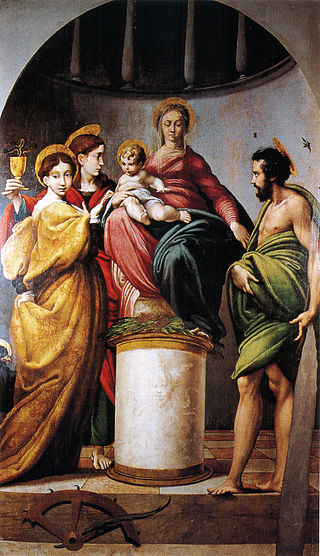
Antonio Allegri da Correggio, usually known as just Correggio was an Italian Renaissance painter who was the foremost painter of the Parma school of the High Renaissance, who was responsible for some of the most vigorous and sensuous works of the sixteenth century. In his use of dynamic composition, illusionistic perspective and dramatic foreshortening, Correggio prefigured the Baroque art of the seventeenth century and the Rococo art of the eighteenth century. He is considered a master of chiaroscuro.

Girolamo Francesco Maria Mazzola, also known as Francesco Mazzola or, more commonly, as Parmigianino, was an Italian Mannerist painter and printmaker active in Florence, Rome, Bologna, and his native city of Parma. His work is characterized by a "refined sensuality" and often elongation of forms and includes Vision of Saint Jerome (1527) and the iconic if somewhat anomalous Madonna with the Long Neck (1534), and he remains the best known artist of the first generation whose whole careers fall into the Mannerist period.

Giovanni Lanfranco was an Italian painter of the Baroque period.

Bartolomeo Schedoni was an Italian early Baroque painter from Modena.

Girolamo Mazzola Bedoli was an Italian painter active in the Mannerist style.

Parma Cathedral is a Roman Catholic cathedral in Parma, Emilia-Romagna (Italy), dedicated to the Assumption of the Blessed Virgin Mary. It is the episcopal seat of the Diocese of Parma. It is an important Italian Romanesque cathedral: the dome, in particular, is decorated by a highly influential illusionistic fresco by Renaissance painter Antonio da Correggio.

The Assumption of the Virgin is a fresco by the Italian Late Renaissance artist Antonio da Correggio decorating the dome of the Cathedral of Parma, Italy. Correggio signed the contract for the painting on November 3, 1522. It was finished in 1530.

The mystical marriage of Saint Catherine covers two different subjects in Christian art arising from visions received by either Catherine of Alexandria or Catherine of Siena (1347–1380), in which these virgin saints went through a mystical marriage wedding ceremony with Christ, in the presence of the Virgin Mary, consecrating themselves and their virginity to him.

San Giovanni Evangelista is a Mannerist-style, Roman Catholic church located on Piazzale San Giovanni, located just behind the apse of the Parma Cathedral, in the historic center of Parma, northern Italy. The buildings surrounding the piazza were also part of a former Benedictine convent. The church is notable for its Correggio frescoes.

The Galleria nazionale di Parma is an art gallery in Parma, northern Italy.

The Bardi Altarpiece, is an Italian Mannerist painting by the Italian painter Parmigianino, dating from c. 1521 and housed in the church of Santa Maria at Bardi, Emilia-Romagna, Italy.

The Santissima Annunziata, also called the Basilica del Paradiso, is a Renaissance style, Roman Catholic church and convent located on Via Massimo D'Azeglio in Parma, Italy.

San Vitale is a Baroque style, Roman Catholic church located in central Parma, region of Emilia Romagna, Italy. it stands just east of the Palazzo del Comune and Piazza Garibaldi.

Saints Peter, Martha, Mary Magdalen and Leonard or Four Saints is a 1514 oil on canvas altarpiece by Correggio, now in the Metropolitan Museum of Art in New York City. He painted it for the church of Santa Maria della Misericordia and it shows Saint Peter, Saint Martha, Mary Magdalene and Leonard of Noblac.

The Albinea Madonna or Madonna of Albinea is a lost painting by the Italian Renaissance painter Correggio. The best surviving copy is a 16th-century one by Antonio Leto, from the church of San Rocco in Reggio Emilia and now in the Galleria Nazionale di Parma.

The Madonna and Child with the Infant John the Baptist is a 1518 oil-on-panel painting by the Italian painter Antonio da Correggio.

Madonna and Child with Saint George is an oil on panel painting by Correggio dating to around 1530 and now in the Gemäldegalerie in Dresden.

La Zingarella is a 49 x 37 cm oil-on-panel painting executed ca. 1516–17 by the Italian Renaissance painter Correggio. It shows the Rest on the Flight into Egypt, although it omits the figure of Saint Joseph. It is now in the Museo Nazionale di Capodimonte in Naples.

The Conegliano Altarpiece or Madonna and Child with Angels and Saints is an oil painting produced in 1492 by Cima da Conegliano as the high altarpiece for the Duomo di Conegliano in his birthplace.

Madonna and Child with Saints is an oil on canvas painting by Agostino Carracci, from 1585, dated on the lowest step of the Virgin Mary's throne. An example of a sacra conversazione. Long in the Benedictine abbey of San Paolo in Parma, French troops took it to Paris in 1796 and on its return to Italy in 1816 it was moved to the Galleria nazionale di Parma, where it still hangs.




















